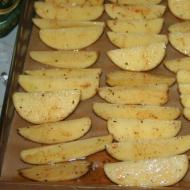
How to get alcohol by freezing brogue. Freezing moonshine - there is an effect. How to successfully remove the aroma of fusel oils
Once upon a time in the fields (geological) we still did this. The outer dish is a tall enameled laundry bin, they don't make them like that anymore. Inside, with an annular gap of a couple of centimeters - a rather flat pan (the handles were pressed in to enter) on a stand of bent copper strips from the ground so that the pan was at the top of the tank. And already inside this pan - another one, of a much smaller diameter and slightly lower height, suspended by the edges flush with the first one with the help of a horizontal stick. The chip was in the shape of a basin, with which it was all covered - usually the basins have the lowest place along the edge of the bottom, and in the middle it is raised, the same one again had a depression in the center, about a third of the diameter (judging by the whole enamel, this came out of the factory) .
Braga from wild honeysuckle with sugar was filtered in a tray through a pile of lime sand, poured into a tank and brought to a state on the verge of boiling without a lid or other insides. The expanses of native nature and the absence of neighbors, of course, removed problems with smell, anti-alcohol laws and more. After a while, the smell became less disgusting (“the taster” had to come up periodically for a few seconds so as not to get used to it), then they put a matryoshka from two pots inside and covered it with a basin with a pad of a damp rag. By the way, the mash was several times smaller in volume than the volume of the tank, it didn’t even get much to the bottom of the pan. From above, water was poured into the basin and then it was regularly “wrapped” - a mug of warm overboard, a mug of cold from a bucket into a basin (the bucket was scooped right there in the stream). The heating was regulated by the fact that not primordial firewood went under the tank, but the firebrands from the fire nearby, they were added or subtracted, focusing on the vibrations of the tank - which, by the way, did not hang, but stood on three stones of a suitable shape and, at the first attempt, began to gurgle quietly flash. The process was also controlled by periodically splashing a drop of water on the side of the tank and watching how far it rolled before it evaporated - at first it reached the bottom, then its path ended higher and higher. At a certain moment, the comrade who was in charge of all this (he also designed the device from cash) ordered to shoot.
As a result, at least half of the alcohol was distilled from the mash, and in two pans there was clearly a different product - in a large, or external, fortress, it was lower, with a noticeable fusel smell, and in the internal, a “tear” with a degree higher than 50%. Our specialist - by the way, a geochemist - explained this in such a way that, firstly, we sent the "head" into the atmosphere, and left the "tails" in the wash, stopping the process at about 97 degrees. Secondly, the first distillate was deposited along the perimeter, on the sides of the basin, and hung in drops on the circumference of the bottom, falling into the outer pan. From there, he again evaporated, because. its boiling point was ten degrees lower than that of mash (all this according to our geochemist), and here it was already deposited mainly in the center of the pelvis, because. an ascending stream of primary vapors, lighter both because of the temperature and because of the molar mass, which is on average higher in a mixture more saturated with alcohol, did not let it to the edges. From the center, of course, dripped into a small saucepan. There was probably some confusion, but not much, judging by the results.
In general, the contents of the small pot went off with a bang, and they wanted to distill the liquid from the large one again the next day, but they didn’t have time - it seemed to the hard workers from the scourges of participation in our cultural drinking, and they quietly finished off the “semi-finished product” in the morning. But even they didn't get sick.
The process, of course, is wasteful, but under these conditions, water, firewood, sand, honeysuckle and fresh air do not count at all, and we had plenty of sugar (geologists were well supplied) and was written off after the season at state prices, i.e. e. and here, anyway, it turned out to be an order of magnitude cheaper than purchased vodka.
Alkofan, do you know anything else about matryoshka distillation devices, where the internal is powered by external steam?
There were not always moonshine stills, so there were several ways to distill mash without this device. These techniques are imperfect and are now practically not used. Freezing mash and making apparatus from pots used to be the main technologies. Today, the distillation of alcohol is carried out in traditional ways, since working with the apparatus is easier and safer. The taste of such moonshine is also high.
Advantages and disadvantages of freezing
Freezing a drink is a method that has lost its relevance for a long time. It is impossible to compare it with full-fledged distillation due to differences in the results of the process. You can mention this technology for historical reference or to conduct an experiment with a drink.
Freezing mash
There are also many rumors about the method. The fact is that after freezing it is impossible to get strong moonshine. As a result, only strong mash is formed. And if people say that a product with a strength of 50 degrees can be obtained after freezing - this is a lie. But even to strengthen the mash, using this method is undesirable. The main disadvantages of freezing:
- Harmful substances that are formed in the product after fermentation, namely methanol, aldehydes, fusel oils, will remain in the drink. Heat treatment in the form of lowering the temperature will not affect them. These substances will harm health and will contribute to intoxication of the body. In addition, after freezing, part of the water will go away, which means that the relative concentration of fusel oil and aldehydes will increase. To get rid of these substances, moonshine should be distilled in the traditional way. During the first distillation, the drink is divided into fractions, during which the “heads” are cut off from the “tails”.
- And for the technique you need certain weather conditions. The problem is that a refrigerator or conventional freezer cannot operate at the temperature required for freezing. The weather outside should also be from minus 25 degrees Celsius and below. And due to changes in climatic conditions and the inconsistency of the weather, it is difficult to choose the time for freezing.
In addition to disadvantages, the technique has advantages that it would be unfair not to mention:
- The method is suitable for increasing the strength of the mash without losing raw materials, that is, water is not lost, and the drink becomes stronger. This allows in the future, during distillation, to get more moonshine with a high strength. For example, from the 12th product, you can get mash 17 or 18 degrees. Therefore, in this way you can save money and, after distillation, get the same strength of an alcoholic beverage, spending less per liter of mash. It also reduces turnaround time. Freezing can serve as a good preparatory step before a full distillation. This is not always used, as the process is laborious, not always beneficial due to climate change.
- Freezing moonshine or mash is a cheap technique that does not require costs. This is done on the streets in central Russia and in the north of the country. No equipment, except for containers directly with moonshine, will be needed for freezing.
- The technique does not require additional equipment, it is simple and understandable even for beginners.
The process is based on a physical phenomenon. It is based on the difference in the freezing temperature of alcohol and other components of the mash. Pure ethyl alcohol freezes at minus 114 degrees Celsius, while water freezes at zero. Therefore, the water will freeze, and the drink will remain in liquid form and it can be poured into containers. It can be filtered later.
Recipes and procedures
The method has its own algorithm or technology, which depends on the region in which the freezing is carried out. The main method consists of the following steps:
- a container with mash is placed in the freezer;
- set the lowest temperature there;
- the liquid is drained after 5-6 hours, it is usually located in the center.
In Siberia and other cold regions, they do this: the highest possible angle of metal is placed at an angle in the cold. At the same time, the air temperature should drop to minus 30 degrees Celsius. At the bottom, under the corner, a container is installed for collecting moonshine, for example, a bank.
Braga at this time is poured onto a metal corner. The drink gradually passes to the jar and the water freezes in the cold, while the degree of mash grows. After the first freezing, you need to change the metal plates and put clean ones. And for greater strength, the procedure can be carried out a couple of times.
Today, experiments are being carried out not only in terms of freezing the mash, but moonshine is also cleaned with cold. Cleaning moonshine with cold is more popular than with mash, but is also rarely used, because in books the freezing technique is called unpromising. In moonshine, as a result, the degree rises, and substances that have not dissolved before begin to react and become part of alcohol. There are methods that include activated charcoal and alkalis that are used to purify alcohol and do not affect the composition of the drink.
The method is really not in demand, but grandfathers received moonshine in this way. As a result, freezing gives not only a high concentration of fusel oil, but even the smell and taste of the drink remain unpleasant.
Refrigeration of homemade alcohol is a method that has been popular in cold climates for centuries. And today in Siberia, moonshine and even mash are being frozen.
In the same place where frosts over 25 ° C are very rare, freezers of ordinary refrigerators are widely used today.
And those who have acquired a chest freezer are practically unlimited in their experiments with freezing both mash and finished distillate.
Although freezing is perhaps the oldest attempt to improve taste and has been practiced since the time of Ivan the Terrible (XV century), the method does not guarantee complete elimination of fusel oils and other stinking, harmful muck that moonshine abounds in.
The method is notable for its availability and is practiced by many distillers to this day. Who (in the North) freezes alcohol on the street in winter, who uses the freezer for this. Why is freezing so attractive:
- no need to defend, wait for the flakes to settle and filter. Frozen water remains in the container, unfrozen alcohol is drained;
- moonshine becomes much cleaner, since a large amount (not all) of fusel oils freeze with water;
- the strength increases due to dehydration of the product;
- the smell disappears and the foreign taste becomes weaker. Many people remember the "army way" to make cologne more or less drinkable.
Freezing Disadvantages
Although some of the substances called fuselage are removed by freezing, low temperatures do not affect the most dangerous of them. The maximum that modern freezers give out is minus 28 ° С.
Reference. Freezing point of isoamyl alcohol: -117°C, isobutyl alcohol: -108°C, furfural: -36.5°C. Methyl (wood) alcohol freezes at sub-zero temperatures below 96°C.
Cold cleansing options
Consider several methods known in folk practice.
Important. In all cases, before cleaning moonshine with cold, it is strongly recommended that you first pass it through coal (coal column or filter).
This will remove the mentioned substances with a very low freezing point.
In the freezer
Option 1. Pick up a metal container that can be closed and placed in the freezer. Pour homemade distillate and send for 4 hours to freeze. During this time, crystals of frozen water with impurities form on the walls. It remains to drain pure strong alcohol.
Option 2. The same, but using plastic containers (bottles, large bottles). It is advisable to extend the stay in the freezer up to 6-8 hours.
On scrap
 The old Siberian method provides for the presence of severe frost on the street - from minus 25 ° C and below.
The old Siberian method provides for the presence of severe frost on the street - from minus 25 ° C and below.
Place a metal corner (for those who have little experience) or scrap in a bucket or other utensil and lean against the wall at a slight slope.
Pour the moonshine into the hollow of the corner (for scrap). Water and fuselage will freeze to the metal until the trickle reaches the bottom. Only alcohol will enter the container.
Chemistry plus frost
- Use NaOH (caustic soda) - 2 g per liter of moonshine. First, dissolve caustic soda in a small amount of water, then add it to homemade distillate, stir and put it in the freezer for 4-5 hours. Drain the unfrozen part, filter through cotton wool, dilute to 15-20 ° C and distill a second time.
- Dilute with water (a tablespoon per liter of raw alcohol). Mix the liquids, put in the freezer overnight. Drain and filter. If the taste suits, you can not distill again.
After freezing by any of the proposed methods, moonshine invariably becomes softer and more pleasant to drink. The sharp fuselage smell disappears. But for high-quality disposal of various impurities in home distillate, it is better to combine this method with other cleaning methods.
Like, if the article is useful to you, share it through social networks.
Modern moonshine stills make it possible to drive home-made alcohol without the content of harmful substances and without a fusel smell. Manufacturers offer modern moonshine devices equipped with a steamer, a good cooler or equipped with distillation columns. Thermometers and regulators allow you to maintain the desired distillation temperature. Such devices allow you to drive moonshine of good quality.
The disadvantages of factory devices can be recognized as the high cost of products. Inexpensive models do not provide high-quality cleaning, while in most of these devices the distillation cube has a small volume, which significantly lengthens the distillation period. Good models with a sufficient amount of distillation capacity are worth good money. Therefore, it is possible to make the processing of home brew using old-fashioned methods, and then re-distill the moonshine using an inexpensive factory-made apparatus.
rustic method
This method is also called black distillation of moonshine. Its essence is as follows. A container for collecting condensate is installed in a container of the appropriate size. The device is closed by a basin in which cold water is poured. Heated vapors containing alcohol condense on the surface of the basin with cold water and drain into the resulting container. As it warms up, the container in the basin changes to cold. The result is moonshine, the smell of which turns back, and it is simply impossible to use it. The resulting liquid is purified and subjected to repeated distillation.
Even with such a simple distillation method, there are technological features. The collection container installed in the tank should be 3-5 cm in diameter less than the distillation cube, and at the same time not touch the hot mash. The place of contact of the top of the tank and the basin with cold water should be sealed with a cloth, dough  or clay. This will protect against a peculiar smell and the loss of vapors containing alcohol. After the process is completed, the removed container with moonshine should be held for 5-10 minutes. in the open state and only then pour into a vessel. This procedure will allow you to get rid of light ethers and aldehydes and other low-boiling chemical compounds.
or clay. This will protect against a peculiar smell and the loss of vapors containing alcohol. After the process is completed, the removed container with moonshine should be held for 5-10 minutes. in the open state and only then pour into a vessel. This procedure will allow you to get rid of light ethers and aldehydes and other low-boiling chemical compounds.
After a slight improvement in this design, you can drive out better moonshine, but you won’t be able to completely get rid of the smell. To do this, a hole must be made in the distillation tank just below the bottom of the receiving tank. A hole is also drilled in the bowl for collecting moonshine and a tube with an inner diameter of 3-5 mm is welded. Then it is taken out under a slope through a hole in the tank, which is then sealed. This improvement will allow you to separate easily boiling fractions and control the output of moonshine. In the presence of a juice cooker, it can also be used as an apparatus for distilling mash into moonshine. To do this, instead of a grid for laying raw materials, a basin with water is installed, and mash is poured instead of water. The disadvantage of the juice cooker in the process of distillation of the mash is the insufficient volume of the poured raw materials.
Freezing moonshine
This method can be used in winter or if a good freezer is available. The essence of the method lies in the fact that the water contained in the mash with part of the impurities is frozen and turns into ice, and the liquid moonshine is drained. In order to obtain alcohol by freezing, it is clarified with bentonite or allowed to settle for 7-10 days. After that, the container with the mash is taken out into the cold and left there for 1-2 days. During this time, the mash freezes and turns into loose ice mixed with moonshine. After that, the container is turned upside down, and the moonshine is drained into the substituted container. The advantage of this method of obtaining moonshine is the absence of additional energy costs and the absence of a specific smell in the room. In the summer, a container with mash can be placed in the freezer. If the container is large and everything does not fit into the chamber, then the alcohol-containing liquid can be poured into plastic bottles and easily frozen.
The following freezing method can only be carried out in severe frosts from -20 ° C and below. To do this, you will need to make a tray at least 2 m long and install it at a slight slope. To the top  From the tray, clarified mash pours in a thin stream, water freezes to the tray, and moonshine flows into the substituted container. When arranging such a device, it should be borne in mind that the longer the tray and the smaller the slope, the stronger and better the moonshine will turn out. The tray can be made of wood or plastic, but metal is best. The resulting liquid can be passed through the tray an infinite number of times, but it will not be possible to significantly improve the quality of the resulting product and get rid of the smell. With this method of freezing, the mash should first be cooled to a temperature of 2-3 ° C, this will significantly speed up the process.
From the tray, clarified mash pours in a thin stream, water freezes to the tray, and moonshine flows into the substituted container. When arranging such a device, it should be borne in mind that the longer the tray and the smaller the slope, the stronger and better the moonshine will turn out. The tray can be made of wood or plastic, but metal is best. The resulting liquid can be passed through the tray an infinite number of times, but it will not be possible to significantly improve the quality of the resulting product and get rid of the smell. With this method of freezing, the mash should first be cooled to a temperature of 2-3 ° C, this will significantly speed up the process.
Disadvantages of Non-Apparatus Methods
The main disadvantage of these methods? the impossibility of obtaining a high-quality drink without odor and a large amount of harmful impurities. The moonshine obtained in this way contains a large amount of fusel oils, esters, aldehydes and similar goodies that adversely affect the body. It is impossible to get noble drinks from such moonshine and this will require its further processing, using better devices. Also, with the rustic method, it is impossible to control the process of obtaining and the strength of moonshine, everything is done by eye, so each time the resulting product has different properties. You should also take into account the fact that when removing the receiving bowl from the tank with hot mash, you can get serious burns.
Only people of the scientific circle could, purification and strengthening of alcohol-containing liquids (wine, home brew) was carried out by freezing. Yes, and during the “prohibition” period, alcohol was obtained in this way from technical and perfumery liquids. Let's talk about how successful this method can be, and what are.
The essence of cleaning moonshine by freezing at home
Water and alcohol freeze at different temperatures. Water - at 0°С, ethanol - at -114°С. Thus, it is assumed that harmful impurities, remaining in the water, will freeze along with it, and alcohol, having significantly strengthened, will remain in the liquid phase. However, in modern literature (“Production of alcoholic beverages”, authors Dorosh A.K., Lysenko V.S.) it is noted that the main impurities of the category of fusel oils - isoamyl and isobutyl alcohols are better soluble in ethanol than in water. And this means that when water freezes and the concentration of ethanol increases, these substances will “migrate” from the aqueous medium to the alcohol one. The same furfural will also not remain “in the thickness of the ice”, but will move to the ethanol molecules. Thus, the concentration of impurities will not only not decrease, but even increase, since the freezing point of these harmful substances is close to the freezing point of ethanol itself. Therefore, cleaning moonshine by freezing (freezing, frost, cold, freezing) from smell and fusel oils will be ineffective.
And yet, the age-old practice of freezing shows that this method is applicable if used in combination with other cleaning methods. The fact is that in addition to “fusel oil”, the distillate may contain other undesirable impurities that are better soluble in water than in alcohol. Therefore, some of the harmful substances can still be removed. An example of this is fatty acids, which precipitate as a white precipitate when the distillate is frozen. It can be easily separated by filtration.
Pros and cons of the method
Cleaning moonshine by freezing (freezing, frost, cold, freezing) is good because it is a completely environmentally friendly method that does not require the addition of chemicals or other substances. Therefore, there will be no harm from such a method at all. But the benefits of using it separately will not be so great, therefore this method of using low temperatures can be considered effective only in combination with other cleaning methods (for example, oil, milk or coal).
How to clean moonshine by freezing
To clean the distillate in this way, you will need a freezer (temperature -20 ° C) or a winter season (a stable negative temperature below -10 ° C), as well as metal utensils. The latter can be replaced with a piece of metal, it is important that there is at least some kind of cold accumulator.
There are several options for the freezing procedure:
- Freezer and metal container
- Freezer and plastic container
- Frosty day and sheet of metal (or iron corner)
Freezer and metal container
Moonshine is poured into an iron dish with a tight-fitting lid (it is better to pre-clean it with coal or milk). Remove the container in the freezer with a temperature of -20 ° C. After 5-8 hours, drain the liquid fraction (purified alcohol solution), and dispose of the ice.
Freezer and plastic container
Pour moonshine with a strength of no higher than 40 degrees into a plastic bottle, close tightly and put in the freezer. After 12-20 hours, ice crystals form in the solution, which must be carefully removed.
By the way, with the help of freezing, the quality of vodka is determined: if it has become viscous, but there are no ice in it, then this indicates its high quality. But if ice crystals appeared in vodka, then its quality leaves much to be desired: it contains impurity molecules that have become “crystal formation centers”.
Frosty day and a sheet of metal
A method that came to us from Siberian villages. Instead of a metal sheet, it is also convenient to use scrap or a metal corner. On metal, pre-chilled in the cold, moonshine is poured in a thin stream. The longer the “path” to the receiving container, the “cleaner” the drink will be. Water with impurities freezes on iron, and alcohol in the liquid phase flows into a receiving container at the bottom of the sheet (scrap, corner). The disadvantage of the method is that in many cases the distillate acquires a characteristic “metallic” taste. If you plan to use this method, then carefully consider the choice of metal.
And yet, the freezing method is a “half-measure” in the production of strong home-made alcohol. To get high-quality and safe drinks, it is better (we recommend choosing a device with a distillation column brand). And to purify the distillate, use the second fractional distillation method. Well, if you do not know how to choose a moonshine still correctly, then be sure to read this information on our portal.
















